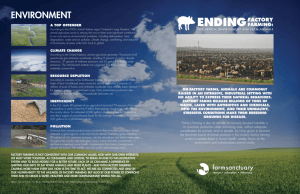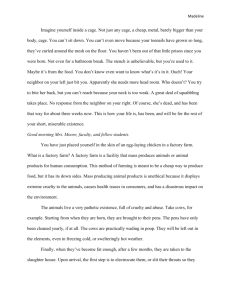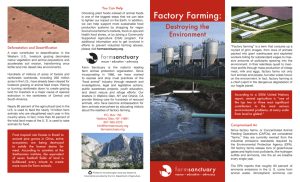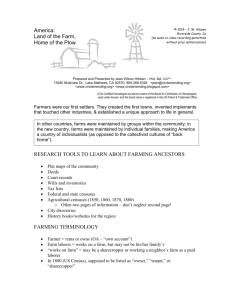ransacked resources garbage in, garbage out air
advertisement
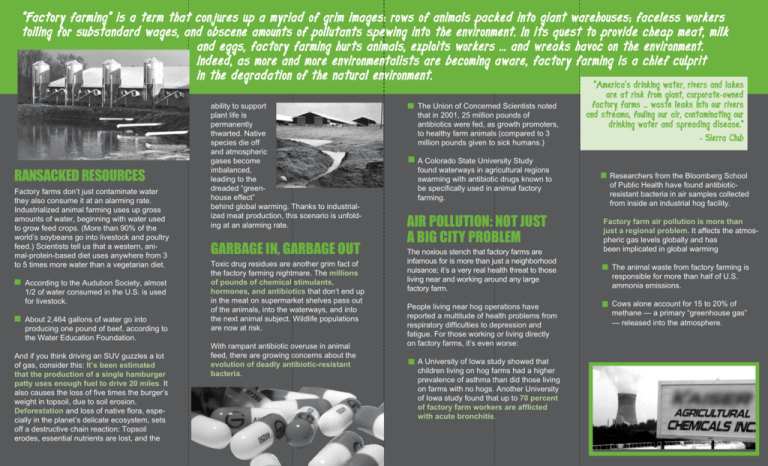
“Factory farming” is a term that conjures up a myriad of grim images: rows of animals packed into giant warehouses; faceless workers toiling for substandard wages, and obscene amounts of pollutants spewing into the environment. In its quest to provide cheap meat, milk and eggs, factory farming hurts animals, exploits workers ... and wreaks havoc on the environment. Indeed, as more and more environmentalists are becoming aware, factory farming is a chief culprit in the degradation of the natural environment. RANSACKED RESOURCES Factory farms don’t just contaminate water they also consume it at an alarming rate. Industrialized animal farming uses up gross amounts of water, beginning with water used to grow feed crops. (More than 90% of the world’s soybeans go into livestock and poultry feed.) Scientists tell us that a western, animal-protein-based diet uses anywhere from 3 to 5 times more water than a vegetarian diet. According to the Audubon Society, almost 1/2 of water consumed in the U.S. is used for livestock. About 2,464 gallons of water go into producing one pound of beef, according to the Water Education Foundation. And if you think driving an SUV guzzles a lot of gas, consider this: It’s been estimated that the production of a single hamburger patty uses enough fuel to drive 20 miles. It also causes the loss of five times the burger’s weight in topsoil, due to soil erosion. Deforestation and loss of native flora, especially in the planet’s delicate ecosystem, sets off a destructive chain reaction: Topsoil erodes, essential nutrients are lost, and the ability to support plant life is permanently thwarted. Native species die off and atmospheric gases become imbalanced, leading to the dreaded “greenhouse effect” behind global warming. Thanks to industrialized meat production, this scenario is unfolding at an alarming rate. GARBAGE IN, GARBAGE OUT Toxic drug residues are another grim fact of the factory farming nightmare. The millions of pounds of chemical stimulants, hormones, and antibiotics that don’t end up in the meat on supermarket shelves pass out of the animals, into the waterways, and into the next animal subject. Wildlife populations are now at risk. With rampant antibiotic overuse in animal feed, there are growing concerns about the evolution of deadly antibiotic-resistant bacteria. The Union of Concerned Scientists noted that in 2001, 25 million pounds of antibiotics were fed, as growth promoters, to healthy farm animals (compared to 3 million pounds given to sick humans.) A Colorado State University Study found waterways in agricultural regions swarming with antibiotic drugs known to be specifically used in animal factory farming. AIR POLLUTION: NOT JUST A BIG CITY PROBLEM The noxious stench that factory farms are infamous for is more than just a neighborhood nuisance; it’s a very real health threat to those living near and working around any large factory farm. People living near hog operations have reported a multitude of health problems from respiratory difficulties to depression and fatigue. For those working or living directly on factory farms, it’s even worse: A University of Iowa study showed that children living on hog farms had a higher prevalence of asthma than did those living on farms with no hogs. Another University of Iowa study found that up to 70 percent of factory farm workers are afflicted with acute bronchitis. “America's drinking water, rivers and lakes are at risk from giant, corporate-owned factory farms ... waste leaks into our rivers and streams, fouling our air, contaminating our drinking water and spreading disease.” - Sierra Club Researchers from the Bloomberg School of Public Health have found antibioticresistant bacteria in air samples collected from inside an industrial hog facility. Factory farm air pollution is more than just a regional problem. It affects the atmospheric gas levels globally and has been implicated in global warming The animal waste from factory farming is responsible for more than half of U.S. ammonia emissions. Cows alone account for 15 to 20% of methane — a primary “greenhouse gas” — released into the atmosphere. LEAKING LAGOONS FACTORY FARMING Sixty-nine percent of U.S. waterways are contaminated with agricultural pollutants. At any given time, an estimated 20 billion farm animals inhabit the earth, more than three times the number of humans. The manure production of these animals — an estimated 3 trillion pounds annually — far exceeds what can be used for fertilizer. As a result, huge, open-air lagoons of liquefied waste collect alongside factory farms, harboring dangerous pathogens that can spark potentially fatal disease outbreaks, from salmonellosis to typhoid fever. These cesspools of waste are disasters waiting to happen. When heavy rainfall hits intensive animal farming areas, we inevitably hear reports of ruptured lagoons and subsequent die-offs of native animals and plants. When Hurricane Floyd ripped through North Carolina in 1999, it let loose over 100 million gallons of pent-up hog waste — eight times the amount of the Exxon Valdez spill. In Maryland, continual outbreaks of Pfiesteria piscicida, blamed on the region’s many poultry farms, have killed millions of fish and been linked to skin irritation, short-term memory loss and other cognitive problems in local people. In California, where dairies are the number one source of environmental pollution — a spill from the Heritage Dairy in 2003 spewed 1.3 million gallons of manure into the Sacramento River, tainting waterways up and down the state. But it doesn’t take a huge force of nature to trigger the full destructive potential of excessive animal waste, which contaminates our water supply at an alarming rate. Today 69% of U.S. waterways are contaminated with agricultural pollutants, and the Environmental Protection Agency says that animal waste from factory farming pollutes American waterways more than all other industrial sources combined. According to a 1999 Time magazine report, “In the United States, livestock now produces 130 times as much waste as people do ... These megafarms are proliferating and in populous areas their waste is tainting drinking water.” “DEAD ZONES” — long stretches of coastline bereft of life — are yet another consequence of factory farm pollution. Dead zones result from the poisonous levels of phosphorous and nitrogen run-off, which spark algal blooms that sap water of its natural oxygen supply. Visitors to Gulf of Mexico can see the largest of these dead zones, a 7,700 square-mile area — the size of New Jersey, where the Mississippi River dumps runoff from agricultural zones in 31 states. Consumers can make choices to live more sustainably and to lessen the harm being done to our environment. Eating lower on the food chain, choosing plant foods instead of animal foods, is one step that each person can take to lighten our impact. In addition, shopping at local farmer's markets, food co-ops and health food stores can help support more sustainable food production systems. For additional information and to get involved in efforts to prevent industrialized farming abuses, please contact Farm Sanctuary. FARM SANCTUARY is a national, non-profit organization dedicated to changing the way society views and treats farm animals. Since Farm Sanctuary began in 1986, we have worked to expose and stop the cruel practices of the "food animal" industry through undercover investigations, legal and legislative actions, public awareness projects, youth education and outreach programs, and direct rescue and refuge efforts. P.O. Box 150 · Watkins Glen, NY 14891 Phone: 607-583-2225 · Fax: 607-583-2041 info@farmsanctuary.org www.farmsanctuary.org Printed on recycled paper using soy-based ink. Put simply by the Worldwatch Institute, “Overgrown and resource intensive, animal agriculture is out of alignment with the Earth’s ecosystems.” Destroying the Environment
